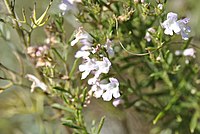
Photo from wikipedia
There has been increasing interest in the food safety, due to growing evidence for several health detriments of chemical additives including preservatives and colors. Since it has already been proven… Click to show full abstract
There has been increasing interest in the food safety, due to growing evidence for several health detriments of chemical additives including preservatives and colors. Since it has already been proven that consumption of chemical colors is associated with complications such as behavior change in children, it is important to evaluate plant pigments as new food colors. In addition to the palatability of their color, in the present study, the antimicrobial and antioxidant characteristics of three carotenoids (annatto, paprika and lutein) were investigated to find out whether can be used to decrease the chemical preservatives content of food products. The antimicrobial activity of these natural pigments was assessed by determination of MIC and MBC against ten microorganisms. The results indicated that all tested carotenoids, especially annatto, have antimicrobial effect particularly against Gram-positive bacteria including Staphylococcus aureus, Staphylococcus epidermidis, Bacillus cereus, Bacillus subtilis, Listeria monocytogenes and Streptococcus pyogenes. Among them, the most susceptible strain was B. subtilis (MIC = 0.093 mg/mL, MBC = 0.187 mg/mL). Moreover, the antioxidant properties were also evaluated using two assays: one in aqueous system (DPPH) and another in lipid system (β-carotene bleaching test, BCB). Both antioxidant assays (DPPH and BCB) confirmed that annatto has potent antioxidant activity (IC50 = 68.52 and 73.12 μg/mL, respectively) in comparison with the tested formulation of paprika and lutein. These findings demonstrated that natural pigments may be interesting additives for use as food colors and co-preservatives to reduce chemicals in food matrices.
Journal Title: Journal of Food Measurement and Characterization
Year Published: 2017
Link to full text (if available)
Share on Social Media: Sign Up to like & get
recommendations!